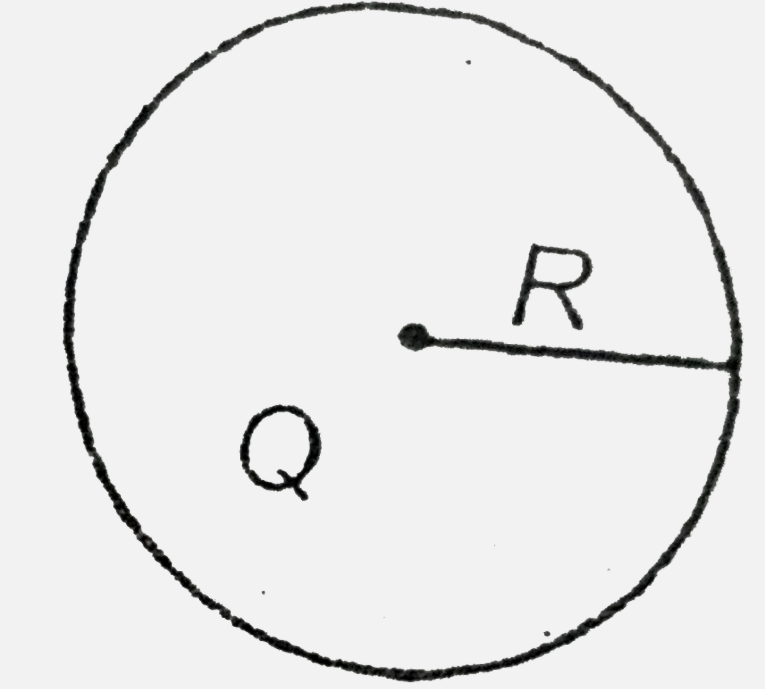A spherical conductor A of radius r is placed concentrically inside a conducting shell B of radius R(R>r). A charge Q is given to A , and then A is joined to B by a metal wire. The charge flowing from A to B will be
Q(RR+r)
R(QR+r)
Q
Zero
The correct Answer is:C
To solve the problem step by step, let's analyze the situation involving the spherical conductor A and the conducting shell B.
Step 1: Understand the Setup
We have two concentric spherical conductors:
- Conductor A (inner sphere) with radius r and charge Q.
- Conducting shell B (outer sphere) with radius R (where R>r).
Step 2: Determine the Initial Potential
The potential V of a charged conductor is given by the formula:
V=kQr
where k is the electrostatic constant, Q is the charge, and r is the radius of the conductor.
- The potential at the surface of conductor A (denoted as VA) is:
VA=kQr
- The potential at the surface of conductor B (denoted as VB) is initially zero because it is a conducting shell and has no charge initially:
VB=0
Step 3: Calculate the Potential Difference
The potential difference ΔV between the two conductors is:
ΔV=VB−VA=0−kQr=−kQr
Step 4: Joining A and B with a Wire
When a metal wire connects A and B, charge will flow from A to B until the potential difference becomes zero. The charge will flow until the potentials of both conductors equalize.
Step 5: Final Charge Distribution
Since the potential of conductor B will be influenced by the charge that flows from A, we denote the charge that flows from A to B as Q′.
- After the charge Q′ flows from A to B, the new charge on A will be Q−Q′ and the charge on B will be Q′.
Step 6: Set the Final Potentials Equal
At equilibrium, the potentials of both conductors must be equal:
V′A=V′B
Substituting the expressions for the potentials:
k(Q−Q′)r=kQ′R
Step 7: Solve for Q′
By simplifying the equation:
Q−Q′r=Q′R
Cross-multiplying gives:
R(Q−Q′)=rQ′
Rearranging the equation:
RQ−RQ′=rQ′
RQ=RQ′+rQ′
RQ=Q′(R+r)
Thus, we can solve for Q′:
Q′=RQR+r
Conclusion
The charge flowing from conductor A to conductor B is:
Q′=RQR+r
We have two concentric spherical conductors:
- Conductor A (inner sphere) with radius r and charge Q.
- Conducting shell B (outer sphere) with radius R (where R>r).
The potential V of a charged conductor is given by the formula:
V=kQr
where k is the electrostatic constant, Q is the charge, and r is the radius of the conductor.
VA=kQr
VB=0
The potential difference ΔV between the two conductors is:
ΔV=VB−VA=0−kQr=−kQr
When a metal wire connects A and B, charge will flow from A to B until the potential difference becomes zero. The charge will flow until the potentials of both conductors equalize.
Since the potential of conductor B will be influenced by the charge that flows from A, we denote the charge that flows from A to B as Q′.
At equilibrium, the potentials of both conductors must be equal:
V′A=V′B
Substituting the expressions for the potentials:
k(Q−Q′)r=kQ′R
By simplifying the equation:
Q−Q′r=Q′R
Cross-multiplying gives:
R(Q−Q′)=rQ′
Rearranging the equation:
RQ−RQ′=rQ′
RQ=RQ′+rQ′
RQ=Q′(R+r)
Thus, we can solve for Q′:
Q′=RQR+r
The charge flowing from conductor A to conductor B is:
Q′=RQR+r
Topper's Solved these Questions
- BOOK - VMC MODULES ENGLISHCHAPTER - ELECTROSTATICSEXERCISE - LEVEL - 260videos
ELECTROSTATICS
- BOOK - VMC MODULES ENGLISHCHAPTER - ELECTROSTATICSEXERCISE - JEE MAIN65videos
ELECTROSTATICS
- BOOK - VMC MODULES ENGLISHCHAPTER - ELECTROSTATICSEXERCISE - LEVEL - 0 (LONG ANSWER TYPE )8videos
ELECTROSTATICS
- BOOK - VMC MODULES ENGLISHCHAPTER - ELECTROMAGNETIC INDUCTION & ALTERNATIVE CURRENT EXERCISE - IMPECCABLE52videos
ELECTROMAGNETIC INDUCTION & ALTERNATIVE CURRENT
- BOOK - VMC MODULES ENGLISHCHAPTER - ENERGY & MOMENTUMEXERCISE - JEE ADVANCE (ARCHIVE) - TRUE/FALSE TYPE1videos
ENERGY & MOMENTUM
Similar Questions
A common test to find the genotype of a hybrid is by
View SolutionA conducting sphere A of radius a, with charge Q, is placed concentrically inside a conducting shell B of radius b. B is earthed. C is the common center of AandB. Study the following statements.
(i) The potential at a distance r from C, where
a≤r≤b,is14πε0(qr)
(ii) The potential difference between AandB is
14πε0Q(1r−1B)
(iii) The potential at a distance romC, where
a≤r≤b,is14πε0Q(1r−1B)
Which of the following statements are correct ?
 .View Solution
.View SolutionPotential at a point x-distance from the centre inside the conducting sphere of radius R and charged with charge Q is
View SolutionA conducting sphere of radius R and carrying a charge Q is joined to an uncharged conducting sphere of radius 2R. The charge flowing between them will be
View SolutionA conducting sphere of radius R, carrying charge Q, lies inside uncharged conducting shell of radius 2R. If they are joined by a metal wire,
View SolutionTwo concentric conducting shells of radii R and 2R are having charges Q and -2Q respectively.In a region r
View SolutionA spherical conductor having charge q and radius r is placed at the centre of a spherical shell of radius R and having charge Q (R > r). The potential difference between the two is
View SolutionTwo concentric spherical conducting shells of radii r and R (r<R) carry charges q and Q respectively . The two shells are now connected by a conducting wire. The final charge on the inner shell is
View SolutionInside a charged thin conducting shell of radius R, a point charge +Q is placed as shown in figure potential of shell may be
 View Solution
View SolutionA small conducting sphere of radius r is lying concentrically inside a bigger hollow conducting sphere of radius R. The bigger and smaller spheres are charged with Q and q(Q>q) and are insulated from each other. The potential difference between the spheres will be
View Solution
